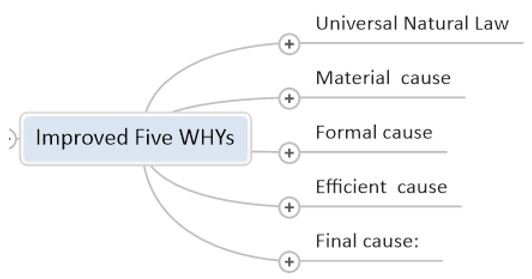When and How to Use the Five Whys Technique
When and How to Use the Five Whys Technique
Definition: The Five Whys Technique is a method of problem solving, which is based upon asking WHY? five consecutive times, in an attempt to understand the root cause of an event.
A visual example of The Five Ways Technique:

Using the Five Whys Technique causes people to look deeper than the immediate causes for an event and encourages finding the root causes.
A root cause could be the cause of many problems, which on the surface are different, but are manifestations of a single fault.
The Five Whys Technique is faulty, because it provides only a single train of thought which is not sufficient to give a full causal explanation, since all events have multiple causes.
Improved Five Whys Technique
Here at Corporate Coach Group, we have an improved version of the Five Whys Technique. Visually it looks like this:

The Corporate Coach Group's Improved Five Whys
1. Universal Natural Law.
Everything and every event is governed by a set of Universal Natural Laws. Events may be explained by reference to these laws, ie the Titanic sank because of the Universal Laws that govern buoyancy, (Archimedes principles) which dictate that ships made of iron are eminently sinkable.
2. Material cause.
Material causes are those which reference the failure of the materials being used. (We don't use chocolate to make teapots!)
3. Formal cause.
Formal causes are those which reference design errors, as the cause of an event. (The Titanic sank partly because the watertight bulkheads were too shallow).
4. Efficient cause.
Efficient causes are those which reference the obvious trigger for the event under question. (The man died because he was shot in the heart by the murderer).
5. Final cause.
Final causes are those which reference human intentions as the cause of an event. (For example, the man was murdered because the thief wanted his money).
How to use the Improved Five Whys Technique
1. Write down the event and start with the most obvious explanation, which is the "efficient cause", which is the obvious trigger that caused the event. For the Twin Towers disaster, the obvious cause is the aeroplanes crashing into the Towers.
2. Then, if the event was caused by human action or neglect, then identify the "final causes". Write down those human decisions and goals, which contributed to the event and ask yourself, what aims were the participants attempting to actualise? For the Twin Towers, the causes would include the religiously motivated intentions of the hijackers.
3. Then look at "formal causes" which are the design errors or failures, that contributed to the event. Look for faulty designs and list them as potential causes. For the Twin Towers, the design of the Towers did not include any considerations for the eventuality of a fully-fuelled passenger jet crashing into it.
4. Then look for "material causes", which are the materials that were in use, and which may have contributed to the event. For the Twin Towers, the material causes may have included the "ties" that held the steel structure together, and which melted under the intense heat of the fire. Could other materials have been better suited to the task?
5. Universal Laws of Nature. There are universal laws of nature that govern everything, one of which is, "for every action, there is an equal and opposite reaction". The Americans have been at war with Muslim countries since the first Gulf war in 1991. Since every action, creates an equal and opposite reaction, then America's attack on Muslim countries, may be considered one of the causes of a Muslim attack on America.
Next time you have a problem, try using the Improved Five Whys Technique. You may be surprised what the five whys analysis will reveal to you.
Definition: Improved Five Whys Technique
In business, the Improved Five Whys Technique is a problem solving method that 1) studies five cause levels – natural law, material, design, trigger and human aim; 2) asks “why” at least five times to reach each level; 3) follows more than one path so thinking is not stuck on a single line; and 4) ends with clear actions that stop the fault coming back.
Show CG4D Definition
- studies five cause levels – natural law, material, design, trigger and human aim
- asks “why” at least five times to reach each level
- follows more than one path so thinking is not stuck on a single line
- ends with clear actions that stop the fault coming back
Article Summary
Asking 'why?' five times digs below surface blame, yet true root cause sits in five linked layers: natural law, material, design, trigger and human intent. Use this improved Five Whys technique and you spot hidden links, stop repeat faults and guide better action in work and life.
Frequently Asked Questions
Here are some questions that frequently get asked about this topic during our training sessions.
What is the aim of the Five Whys technique?
Why can the traditional Five Whys give weak answers?
What are the five cause levels in the improved Five Whys?
How does material cause differ from formal cause?
When should I stop asking “why” in root cause analysis?
How can universal natural law affect a business problem?
What is the first step when using the improved Five Whys?
Thought of something that's not been answered?
Did You Know: Key Statistics
A 2024 BSI survey of 600 UK manufacturing plants found that firms that used a structured Five Whys session after each breakdown cut repeat faults by 37% within one year. Gartner projects that by 2025, 70% of large companies will include a formal root cause analysis stage in every high-impact incident review, up from 45% in 2021.Blogs by Email
Do you want to receive an email whenever we post a new blog? The blogs contain article 5-10 minutes long - ideal for reading during your coffee break!
Further Reading in Decision Making and Problem Solving
-
Perception Bias in the Workplace
Learn what perception bias is, why it harms teams and how to spot and stop it in recruitment. Use written criteria to cut unconscious bias and hire on fact.
Read Article > -
How Rational Thinking is the Key to Success
Learn how rational thinking and logical reasoning help you align with natural laws, remove contradictions and reach lasting success at work and in life.
Read Article > -
Effective Decision Making
Learn how six decision matrix types simplify effective decision making. Compare options, cut bias and act with confidence. Free decision making apps included.
Read Article > -
Influencing Decisions When You're Not the Most Senior Person
Learn how to influence decisions and persuade senior leaders with clear thinking, precise language, solid evidence and confident delivery, even without a title.
Read Article > -
Be a Straight Thinker
Learn four simple rules for critical thinking that help you verify facts, judge source credibility, resist majority opinion bias and keep your logic clear.
Read Article >
Looking for Leadership and Management Training?
If you're looking to develop your Decision Making and Problem Solving Skills, you may find this Leadership and Management Training Course beneficial:
Open Training Course Pricing and Availability
Next Open Course Starts in 14 days, Cheltenham Gloucestershire, places available






